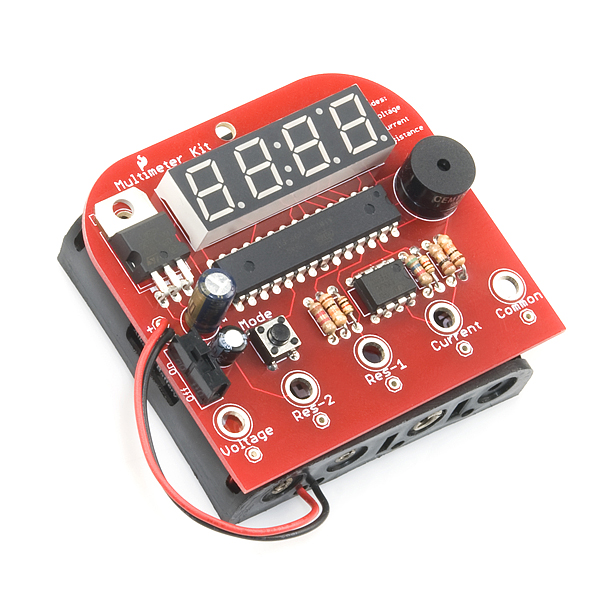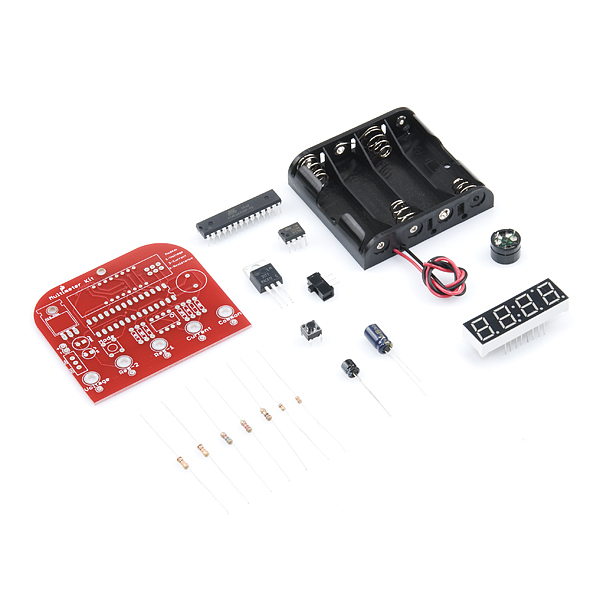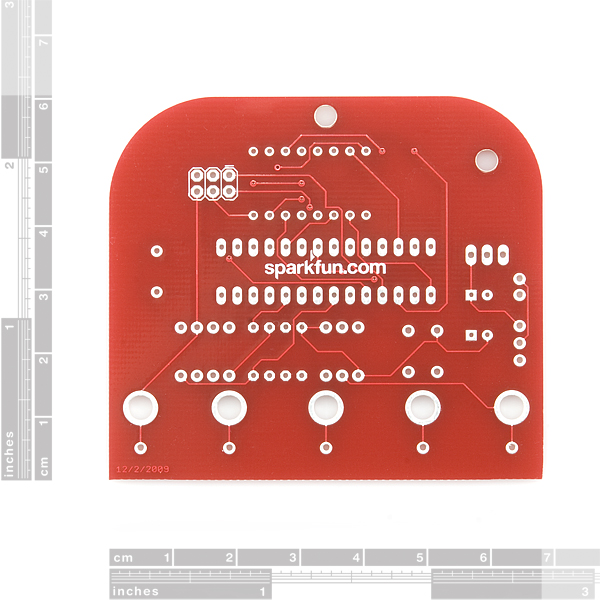Multimeter Kit
Replacement:KIT-10338. The new version of the kit includes test probes. This page is for reference only.
The Multimeter Kit provides you with everything you need to make your own multimeter capable of measure voltage (0-30VDC, 0.05 resolution) current (0-500mA, 1mA resolution) and resistance (0-100kΩ). The resistance mode also includes a continuity test: the buzzer will sound when the resistance probes are shorted together, this is one of the more handy tools of any multimeter.
Using the Multimeter Kit is very straightforward. To measure voltage connect your probes to the 'Voltage' and 'Common' pins, for current measurement the 'Current' and 'Common' pins. Resistance measurement uses the 'Res-1' and 'Res-2' pins. The decimal points are used in resistance measurement mode to indicate 10kΩ and 100kΩ ranges.
The kit doesn't include probes, but you have the option of using banana plug test cables or you can solder simple jumper wires into the smaller probe inputs.
Please note: using the resistance measurement mode on live circuits is not recommended. Also, do not test current or voltage on devices that may be outside the measuring range (no negative voltages or currents)! The multimeter is very simple, and won't replace your Fluke meter, but it works perfectly for simple troubleshooting.
Batteries not included.
- 1x Multimeter Kit PCB
- 1x ATMega328 programmed for Multimeter Kit
- 1x LM358 Op-Amp
- 1x 3.3V Voltage Regulator
- 1x Red 4-Digit 7-Segment Display
- 1x Buzzer 2.048 KHz
- 1x Battery Holder Pack AA x 4
- 1x 100uF Capacitor
- 1x 10uF Capaciator
- 2x 1.0kΩ Resistor
- 2x 10kΩ Resistor
- 1x 5.6kΩ Resistor
- 1x 1.2kΩ Resistor
- 1x 1.0Ω Resistor
- 1x SPDT Mini Power Switch
- 1x Push Button Switch
- Assembly Instructions
- Schematic
- Source Code
Awesome time-lapse assembly video
Be sure to checkout our Surface Mount Soldering Tutorial and our SMD soldering guide.
Be sure to read our How to Use a Multimeter tutorial to find out how to properly use a meter (as if there was a standard way!).
Multimeter Kit Product Help and Resources
How to Use a Multimeter
January 9, 2015
Learn the basics of using a multimeter to measure continuity, voltage, resistance and current.
Comments
Looking for answers to technical questions?
We welcome your comments and suggestions below. However, if you are looking for solutions to technical questions please see our Technical Assistance page.
Customer Reviews
No reviews yet.






Looks like a perfact addition to my Power Supply Project
http://www.jassper.com/other/project.pdf
hi to all people, I want to build a display for a 0-20V DC Voltage source, anyone know how to do this?, I think sould be similar to the concept of this product.
Greeetings-Saludos.
This kit accomplishes your goal out-of-the-box. There's a full schematic and source code in the Documents section, but of course, you could just buy one. What more could you ask for?
A feature to add would be a diode test. My multimeter will tell the voltage drop which is good for LEDs. But I think it's be nice to also test caps, inductors, and transistor pinouts too(the voltage drop from BE compared to BC is different by about a millivolt from my tests).
You could probably program it to do that.
Your parts list is missing the smaller IC...
Good catch, got it updated.